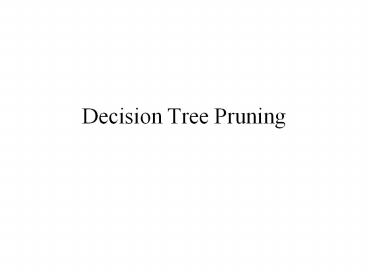Decision Tree Pruning - PowerPoint PPT Presentation
Title:
Decision Tree Pruning
Description:
Reduced Error Pruning. Split the sample to two part S1 and S2. Use S1 to build a tree. Use S2 to sample whether to prune. Process every inner node v ... – PowerPoint PPT presentation
Number of Views:1336
Avg rating:3.0/5.0
Title: Decision Tree Pruning
1
Decision Tree Pruning
2
Problem Statement
- We like to output small decision tree
- Model Selection
- The building is done until zero training error
- Option I Stop Early
- Small decrease in index function
- Cons may miss structure
- Option 2 Prune after building.
3
Pruning
- Input tree T
- Sample S
- Output Tree T
- Basic Pruning T is a sub-tree of T
- Can only replace inner nodes by leaves
- More advanced
- Replace an inner node by one of its children
4
Reduced Error Pruning
- Split the sample to two part S1 and S2
- Use S1 to build a tree.
- Use S2 to sample whether to prune.
- Process every inner node v
- After all its children has been process
- Compute the observed error of Tv and leaf(v)
- If leaf(v) has less errors replace Tv by leaf(v)
5
Reduced Error Pruning Example
6
Pruning CV SRM
- Generate for each pruning size
- compute the minimal error pruning
- At most m different sub-trees
- Select between the prunings
- Cross Validation
- Structural Risk Minimization
- Any other index method
7
Finding the minimum pruning
- Procedure Compute
- Inputs
- k number of errors
- T tree
- S sample
- Output
- P pruned tree
- size size of P
8
Procedure compute
- IF IsLeaf(T)
- IF Errors(T) ? k
- THEN size1
- ELSE size ?
- PT return
- IF Errors(root(T)) ? k
- size1 Proot(T) return
9
Procedure compute
- For i 0 to k DO
- Call Compute(i, T0, S0, sizei,0,Pi.0)
- Call Compute(k-i, T1, S1, sizei,1,Pi.1)
- size minimum sizei,0 sizei,1 1
- I arg min sizei,0 sizei,1 1
- P MakeTree(root(T),PI,0, PI,1
- What is the time complexity?
10
Cross Validation
- Split the sample S1 and S2
- Build a tree using S1
- Compute the candidate pruning
- Select using S2
- Output the tree with smallest error on S2
11
SRM
- Build a Tree T using S
- Compute the candidate pruning
- kd the size of the pruning with d errors
- Select using the SRM formula
12
Drawbacks
- Running time
- Since T O(m)
- Running time O(m2)
- Many passes over the data
- Significant drawback for large data sets
13
Linear Time Pruning
- Single Bottom-up pass
- linear time
- Use SRM like formula
- Local soundness
- Competitiveness to any pruning
14
Algorithm
- Process a node after processing its children
- Local parameters
- Tv current sub-tree at v, of size sizev
- Sv sample reaching v, of size mv
- lv length of path leading to v
- Local Test
- obs(Tv,Sv) a(mv,sizev,lv,?) gt obs (root(Tv),Sv)
15
The function a()
- Parameters
- paths(H,l) set of paths of length l over H.
- trees(H,s) set of trees of size s over H.
- Formula
16
The function a()
- Finite Class H
- paths(H,l) lt Hl.
- trees(H,s) lt (4H)s.
- Formula
- Infinite Classes VC-dim
17
Example
m
lv 3
mv
a(mv,sizev,lv,?)
sizev
18
Local uniform convergence
- Sample S
- Sc x ?S c(x)1, mcSc
- Finite classes C and H
- e(hc) Pr h(x) ?f(x) c(x)1
- obs(hc)
- Lemma with probability 1-?
19
Global Analysis
- Notation
- T original tree (depends on S)
- T pruned tree
- Topt optimal tree
- rv (lvsizev)logH log (mv/?)
- a(mv,sizev,lv,?) O( sqrt rv/mv )? 1
20
Sub-Tree Property
- Lemma with probability 1-?
- T is a sub-tree of Topt
- Proof
- Assume the all the local lemmas hold.
- Each pruning reduces the error.
- Assume T has a subtree outside Topt
- Adding that subtree to Topt will improve it!
21
Comparing T and Topt
- Additional pruned nodes Vv1, , vt
- Additional error
- e(T) - e(Topt) ? (e(vi)-e(Tvi))Prvi
- Claim With high probability
22
Analysis
- Lemma With probability 1-?
- If Prvi gt 12(lopt log H log 1/ ?)/m b
- THEN Prvi gt 2obs(vi)
- Proof
- Relative Chernoff Bound.
- Union over Hl paths.
- V vi ?V Prvigtb
23
Analysis of ?
- Sum over V-V bounded by sopt b
24
Analysis of ?
- Sum of mv lt loptsizeopt
- Sum of rv ltsizeopt(lopt log H log m/ ?)
- Putting it all together































